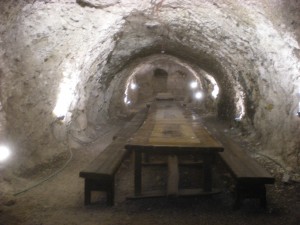
Okay, so last week’s Israel Mystery Photo was a bit more challenging, even for all of my classmates at Machon Lander. But even everyone who was incorrect made logical guesses, which makes this fun!
Also, hiding the comments until now made it more fun as well, since nobody could see the other responses. So I will continue doing that.
So first and foremost, the correct answer was Hurfeish, a Druze town beneath Nebi Sabalan. And though I didn’t ask what it was a picture of, a few people got that one right: a statue of Sultan al-Atrash.
Congrats to Aaron who was the first to answer correctly (and also for identifying al-Atrash). Christine and Warren also got the right location, even if Warren used technological means to figure it out!
Everyone, however, recognized the Druze flag, and connected it with Druze villages in the north. Many guessed Pekiin, which is a major Druze town (though there is something of a mixed population there, and some Jewish history there as well). One of the cool things about this course is the opportunity to learn about the many cultures and religions that are found throughout Israel, and the Druze are certainly an interesting one.
The Druze flag (of which there are a few variations) contains 5 colors: green, red, yellow, blue and white. We heard many different explanations for the Druze flag. This may largely be due to the fact that the Druze have a principal known as Taqiya, which refers to a secretive approach to their faith. Thus, many of the beliefs, practices and symbols of the Druze remain shrouded in mystery.
Benny related one potential meaning of the flag: five prophets who they consider holy figures. Another potential explanation is that it represents five principals of their faith: universal mind, universal soul, the Word, the power of will and the realization of that power. I’ve also seen the colors connected to nature and morals: Green for life and growth, Red for love of mankind and the heart, Yellow for wheat and the sun, Blue for faith and the sky, and white for purity and for the air itself.
Al-Atrash, by the way, was a prominent Druze military leader in the middle of the 20th Century. He was central to Syria’s revolt against the French, leading to its independence. This explains why there might be such a statue in the recently-in-the-news border town of Majdal Shams, as Shai pointed out in his comments. He was also instrumental in forming the Arab Liberation Army, a mixed volunteer army that was one of the many enemies of Israel during its 1948 War for Independence. Despite this, statues of al-Atrash are easily found in prominent places in Israel; we are a democracy, after all.
This week’s mystery photo may be a bit more difficult. It is not very commonly visited, nor is it a major tourist destination. But I do like the spot, so I figured I’d post it and see if anyone outside of my class knows it, as well as how many of my Lander classmates recognize it! Enjoy!

Havent got a clue..
but i do keep coming back for more!
I believe it is the Mony Winery on the grounds of the Dir Rafat Monastery not far from Kibbutz Tzora.
Mony Winery in Gush Etzion?
Dor?
looks a bit like the winery at deir rafat, i remember those long wooden tables in a cave.
Moni winery first tour, with Hughie. in the basement
what does awaiting moderation mean?
Moni Winery next to the Dir Rafat Monastery!?